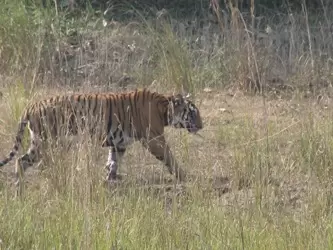‘Incidents of tiger poaching on decline’
09-February-2012
Vol 3 | Issue 5
In cheering news for wildlife conservationists, tiger poaching dropped nearly 60 percent in 2011 as compared to the previous year, though it continues to pose a major threat to the survival of the big cat in the country, a leading NGO said.
According to the Wildlife Protection Society of India (WPSI), 13 tigers were hunted last year as compared to 30 in 2010 - a decline of 57 percent. The bodies of poached tigers, seized bones and skins were computed to arrive at the figures.
 |
|
A tiger roams free and fearless in an Indian jungle (Photo: IANS)
|
Adding other factors like road accidents, infighting, fighting with other animals, electrocution, found dead, and rescue and treatment, the overall toll rises to 61. In 2010, it was 58.
However, top on the list of WPSI's tiger mortality is the found dead figure, 21.
The toll from infighting was the same as that of poaching. In the previous year, 10 tigers died in such fights.
"There has been definitely a decrease in poaching cases in 2011 compared to 2010, but it does not mean poaching has stopped," said WPSI's Tito Joseph.
This could be "due to effective patrolling strategies adopted by the tiger authority (National Tiger Conservation Authority) in coordination with other agencies," Joseph said.
The illegal wildlife trade continues to be a major threat to tigers.
Joseph said traders were offering huge amounts of money in black markets for tiger body parts.
"Recently trade activities were detected in Vietnam and Cambodia. The threat is not only from China (a known hub for such trade) but also from Southeast Asian countries," he said.
"We need to be vigilant 24 hours 365 days," Joseph said.
"Wildlife articles always have a very premium market and prices are not going to come down easily," says U.C. Tiwari, wildlife warden of the Corbett National Park, Uttarakhand.
The 1,200-plus sq km Corbett sanctuary is one of the 39 tiger reserves in the country.
The poaching figure only reflects the cases that come to light and it may not truly reflect the ground condition, said Tiwari. He warned that the situation could turn alarming if the mortality rate of adult tigers rises.
"Because adult tigers don't die easily,... there has to be some extraordinary circumstance."
According to WPSI, of the 21 tigers found dead in 2011 many were adult tigers. In 2010, 15 tigers were found dead.
"The fact that many poachers are now lodged in jails has surely contributed to the decrease. They are still cooling their heels in different jails," the official added.
Acknowledging this, Ashok Kumar, an eminent tiger conservationist and vice chairman of the NGO Wildlife Trust of India, said poaching has reduced considerably as many poachers were jailed.
"Our lawyers fight against them in court so they do not come out of jails.
"All Alwar (Rajasthan)-based poachers are today in jails," said Kumar, referring to a gang blamed for extermination of tigers in the Sariska reserve, one of the two tiger sanctuaries in the state.
Kumar has been at the forefront of the fight against poachers and illegal trade of wildlife for over two decades. He was the first director of Traffic India, which studies wildlife trade.
Rajasthan is also home to the famed Ranthambore National Park. Sariska currently has five tigers, all shifted from Ranthambore as part of a government attempt to repopulate tigers in the reserve.
The latest official tiger census report released in March 2011 estimated about 1,700 tigers in the country. - IANS














